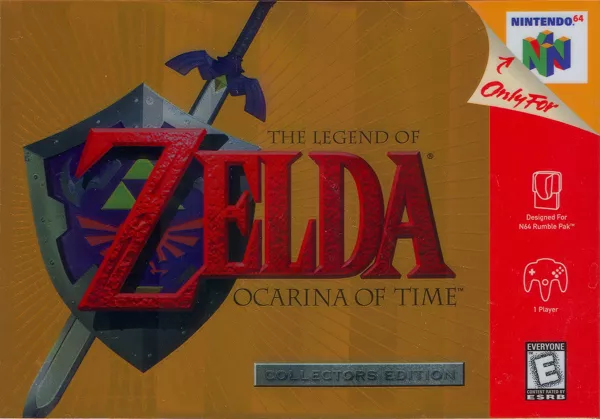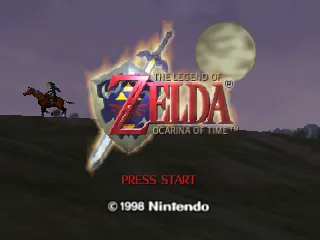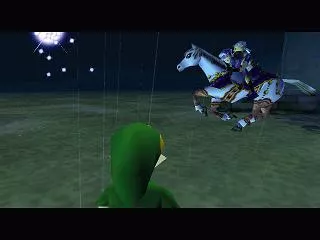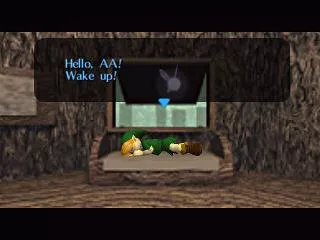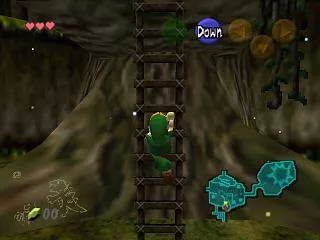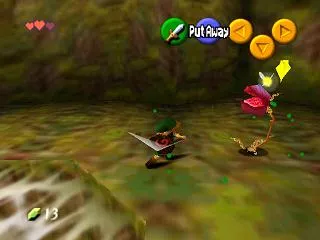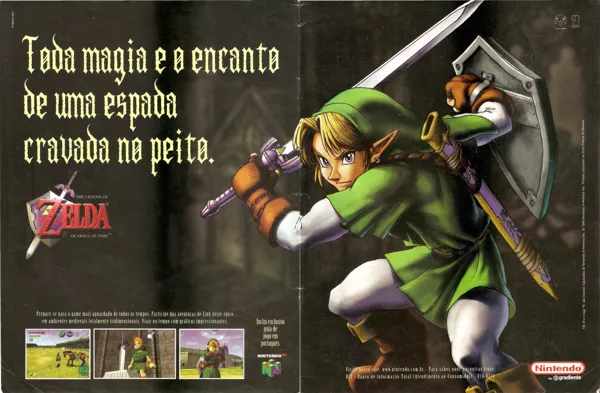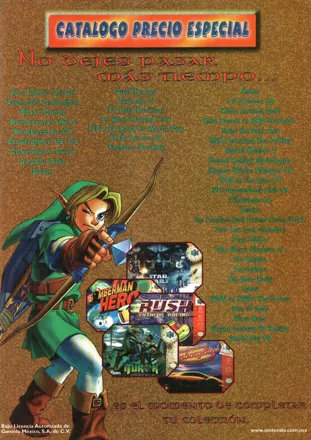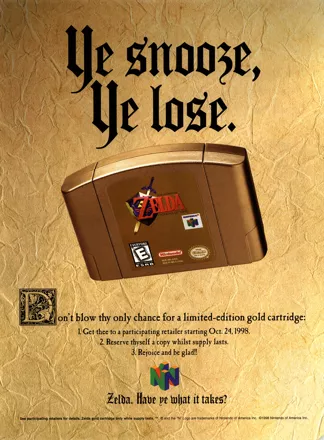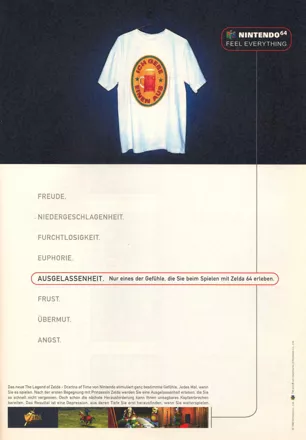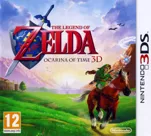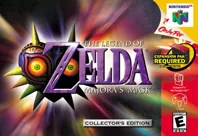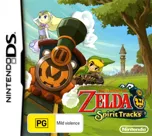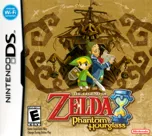The Legend of Zelda: Ocarina of Time
Description official descriptions
A young boy named Link was raised in the village of the elf-like Kokiri people. One day a fairy named Navi introduces him to the village's guardian, the Great Deku Tree. It appears that a mysterious man has cursed the tree, and Link is sent to the Hyrule Castle to find out more. Princess Zelda tells Link that Ganondorf, the leader of the Gerudo tribe, seeks to obtain the Triforce, a holy relic that grants immense power to the one who possesses it. Link must do everything in his power to obtain the Triforce before Ganondorf does, and save Hyrule.
Ocarina of Time is the first 3D installment of the Legend of Zelda series. Like most of its predecessors, it is an action game with puzzle-solving and light role-playing elements. Gameplay is similar to the previous games, allowing Link to explore the world and complete dungeons to obtain key items and advance the plot. Sword combat as well as many familiar items such as boomerang, bombs, the series' currency (rupees) of various values, heart containers, and their collectible fragments permanently increasing Link's health, etc., return in this installment. Link can now lock on enemies for melee and ranged combat, actively use a shield to deflect projectiles, as well as use various magic items. Dungeon exploration is somewhat more puzzle-oriented than in earlier games. Link can climb certain surfaces, dive underwater, as well as automatically jump.
The game begins with the player controlling the child Link, but later on, an adult Link becomes a playable character as well. Each of them has certain unique abilities: for example, only adult Link can use a bow and arrows, but only the child Link can crawl through narrow spaces. During the course of the game, the player obtains the Ocarina of Time. Learning and playing melodies on that ocarina is needed to advance the plot, complete certain side quests, or travel in time, switching between the two versions of Link. It is also possible to befriend and ride a horse named Epona to facilitate travel between areas.
Spellings
- ゼルダの伝説 時のオカリナ - Japanese spelling
Groups +
- Console Generation Exclusives: Nintendo 64
- Game Center CX challenge games
- Gameplay feature: Aging
- Gameplay feature: Auto-mapping
- Gameplay feature: Day / night cycle
- Gameplay feature: Drowning
- Gameplay feature: Equipment quick slots
- Gameplay feature: Fishing
- Gameplay feature: Horse riding
- Games made into books
- Games referenced in movies
- Legend of Zelda series
- Nintendo Player's Choice releases
- Protagonist: Elf
- Setting: Inside a giant creature
- Theme: Time travel
Screenshots
Promos
Videos
See any errors or missing info for this game?
You can submit a correction, contribute trivia, add to a game group, add a related site or alternate title.
Credits (Nintendo 64 version)
76 People (66 developers, 10 thanks) · View all
| Executive Producer | |
| Producer | |
| Director | |
| Program Director | |
| Chief Programmer | |
| Main Program | |
| [ full credits ] | |
Reviews
Critics
Average score: 97% (based on 84 ratings)
Players
Average score: 4.2 out of 5 (based on 437 ratings with 17 reviews)
Possibly the Best Game of ALL Time!
The Good
Altough it's been a while since the initial release, I'm gonna say a few words about this beacon of light anyway. "Ocarina of Time", as the first true 3D-game in the serious, stands out even now as maybe the very best game of all times in my book. Even today I instantly say "Zelda to the 64" when people ask what the best game I've ever played was.
The weeks it took me to complete this game was ABSOLUTE pure magic. I was literally lost in front of the screen from the opening credits and to the final fight with Gannondorf. When the end-sequence slowly faded away fon my screen - and the game was over - I almost started crying. This is a masterpiece through and through, nothing less. I guess it's the friendly gameplay that cought me, as well as the (then) beautiful graphics and polished mechanics. The puzzles got harder and harder, the story more and more intense - and the areas you explored got more and more interesting. I wasn't bored for a second ... a true gem from Nintendo this.
The Bad
I actually thought hard about something negative to say, but I honestly can't think of anything. It would have been fun with a larger selection of armor, gadgets and weapons - but I didnt really miss it at the time, which means the ones I got was enough to keep me happy. Not really anything else to say ...
The Bottom Line
I've been a gamer since ... well, as long as there have been games to play - and I can honestly say this game stands out, even today, as the best game I have ever played. (Rivaled by World of Warcraft and The Curse of Monkey Island)
Nintendo 64 · by SkyMarshall (3) · 2006
The Good
The first time I played this game and I saw the graphics I was stunned. When you start in Kokiri forest and you can see things flying through the air you can pretty much smell the dew on the leaves. The idea that you could go between adult Link and child Link was good also, it was like having two games in one. This is, in my opinion the best of all the Zelda games except for maybe the nintendo ones which are just classics.
The Bad
The only two things that annoyed me about this game was that there were about 4 towns and all together there were about 35 NPC's at the most, so there was not an extreme amount of interaction. And the fact that they show you this big castle that looks beautiful from the outside and you never actually get to go into the castle until it gets taken over by Ganondorf was quite disappointing.
The Bottom Line
In you have played any of the other Zelda games then this game is a definite must. I saw the graphics of the Gamecubes new Zelda : Windwaker i think it was called because I looked at the graphics and it just put me right off. I think this game is well worth playing if you have the time to go through it.
Nintendo 64 · by Horny-Bullant (49) · 2003
A Masterpiece, that stands today still as the best single player expirence ever.
The Good
The N64 was made specificaly for two games:
Zelda : Ocarina of Time.
And Mario 64.
Sure, Nintendo intended other games, but these two games were designed in tandom with the console. The console, in particularly its controll pad, was designed for these games. And these games, of course, were designed for the console.
Ocarina of Time stands as an unbeaten masterpiece, every aspex of its gameplay is finely tuned to perfection. A perfect game is not a game that has no improvements possible, a perfect game is one that couldnt have been made better given the same resources and the same time. This is such a perfection.
I could list indivual elements that make this game so good, but then i would go on all day. The fact that this game is 10 years old and is still the benchmark used for this type of game says a lot.
The only games that come close are its sequals, and even they fall short (due mainly to shorter length)
The Bad
Nothing.
Ok then, one minor thing, the tradiational Zelda themetune wasnt included.
But then, the music in the game is also superb, so thats not a problem.
The Bottom Line
The only games remotely like it are "LBA1 & 2" for the PC.
And even they are completely different.
You can call it an RPG, but it isnt. Its Zelda. A blend of puzzles and sword fighting set in a lush world. Minigames that blend seamlessly with the world, spectacular boss's and an epic plot.
Nintendo 64 · by Darkflame (14) · 2003
Discussion
| Subject | By | Date |
|---|---|---|
| Am I the only one? | GAMEBOY COLOR! (1990) | Jul 15, 2012 |
| Beta screenshots ? | GAMEBOY COLOR! (1990) | Jun 13, 2009 |
Trivia
1001 Video Games
The N64 version of The Legend of Zelda: Ocarina of Time appears in the book 1001 Video Games You Must Play Before You Die by General Editor Tony Mott.
Development
The Legend of Zelda: Ocarina of Time started life in development for Nintendo's 64DD add-on for the Nintendo 64 (which was a disk drive that was only released in Japan with little fanfare). The 64DD flopped in Japan and it wasn't even released in the USA. As a result, this game, instead of being released in disks, was crammed into a cartridge (which was the biggest N64 pre-Expansion Pak cartridge released, in terms of space). Even though it was originally developed and planned for the 64DD, it was announced to much surprise that Zelda would release in cartridge form for the N64 first; further indicating that the disk drive platform was not gaining the traction Nintendo had hoped for.
Cartridge
Due to overwhelming fan requests, Nintendo decided to release the original production releases of the game as a gold-colored cartridge, restoring the 'golden cartridge' lineage that had previously been broken by the SNES version of The Legend of Zelda: A Link to the Past, and The Legend of Zelda: Link's Awakening for Game Boy.
Versions
There are at least three different versions of the game: 1.0, 1.1 and 1.2. The golden (limited edition) carts, as well as some gray carts, are all 1.0. The majority of the ordinary gray carts are 1.1, and many of the later produced ones are 1.2.
The only notable change between 1.0 and 1.1 is that the Fire Temple music was changed a little bit. It had a chant from an Islamic prayer looped in the background which offended some members of the Islamic community. 1.1 also fixed some bugs, the most famous of them being the sword-losing bug. In 1.0, if the player saves the game in the end battle after losing the Master Sword, and restart the game, they don't have the sword anymore, but they can use all items while riding Epona. Also the final boss originally had red blood which was changed to green in a later version.
Fan remake
Daniel Barras was making a PC fan remake of the game, titled Ocarina of Time 2D. Basically, this was to be a remake with all of the story, areas, creatures and items from The Legend of Zelda: Ocarina of Time, using graphics similar to The Legend of Zelda: A Link to the Past. Regrettably, Nintendo was not very happy about this (or any other Zelda remakes that use The Legend of Zelda: A Link to the Past sprite rips), so the project is gone now.
Stone of Agony
The Stone of Agony allows players to feel a rumble to find hidden areas. This of course only works if they have a rumble pack accessory attached to their N64 controller (or are playing the Gamecube version). For the Wii Virtual Console version, this feature has been disabled.
Left-handedness
Link has always been left-handed, but it is particularly noticeable starting with this game. In the original title, this wasn't always noticeable due to sprite-flipping techniques. The reason for Link's left-handedness is that his creator, Shigeru Miyamoto, is also left-handed.
Voice acting
Voice acting for the adult Link was done by Nobuyuki Hiyama, who also did the voice acting for Link in Super Smash Bros. The person who did the voice of Link as a child, Fujiko Takimoto is a woman. This explains Link's extremely high voice.
Ad controversy
An advertisement for Ocarina of Time shown in British TV proved to be controversial. Using the slogan "Willst thou get the girl? Or play like one?", the ad provoked complaints to the Independent Television Commission from viewers who considered it sexist. ITC however ruled against taking the ad off the air, stating that "such tongue-in-cheek treatments were unlikely to have the widespread negative affect that those who complained feared."
References: Zelda series
- Many of the character names, such as Rauru, Mido, Ruto, Saria, and Darunia, are actually names of towns in
Zelda II: The Adventure of Link . - The characters Malon and Talon are based on Marin and Tarin from The Legend of Zelda: Link's Awakening. Marin was a Zelda lookalike who also had a beautiful singing voice.Tarin was her father and had a liking for mushrooms (he resembled Mario).
References
- Both Talon and his assistant Ingo resemble Mario and Luigi, although it's interesting to note that they have an antagonistic relationship. Both Talon and Malon wear medallions that are shaped like Bowser's head.
- Looking through the windows of Zelda's Castle, players can see pictures of Mario, Bowser and other
Super Mario Bros. characters adorning the walls. - When using a GameShark, the player can make Arwings appear that will attack Link. The Arwing is the primary spacecraft of the
Star Fox series . - The horse in the game is named after the Celtic horse goddess, Epona.
- The lantern-carrying ghosts called Poes are named after the famous horror writer
Edgar Allan Poe . - In the Forest Temple the player encounters the four Poe sisters: Joelle, Beth, Amy, and Meg. They are named after the four protagonists of the novel Little Women by
Louisa May Alcott .
Awards
- EGM
- February 1999 (Issue #115) - Game of the Month
- February 2006 (Issue #200) - #8 out of 200 of the "Greatest Games of Their Time" list
- Game Informer
- August 2001 (Issue #100) - #11 on the "Top 100 Games of All Time" poll
- GameSpy
- 2001 – #43 Top Game of All Time
- Nintendo Power
- Issues #196-200 - #1 "Top 200 Nintendo Console Games of All Time"
- Retro Gamer
- October 2004 (Issue #9) – #5 Best Game Of All Time (Readers' Vote)
- WatchMojo
- August 2014 - ranked #1 in the Top 10 Video Games of All Time
- The Strong National Museum of Play
- 2022 – Introduced into the World Video Game Hall of Fame
Information also contributed by Andrew Shepard, Attila, Big John WV, festershinetop, Guy Chapman, Mark Ennis, Matt Neuteboom, ModestMr.Green, Tiago Jacques, WildKard, and WWWWolf.
Analytics
Upgrade to MobyPro to view research rankings!
Related Sites +
-
OC ReMix Game Profile
Fan remixes of music from The Legend of Zelda: Ocarina of Time. -
The Legend of Zelda: Ocarina of Time/Master Quest
Nintendo of America's official web site for the GameCube version. -
Zelda 64 Fan Site
A fan site dedicated to the Nintendo 64 Legend of Zelda -
Zeldapower.com Forums
Message Boards for all of the Zelda games
Identifiers +
Contribute
Are you familiar with this game? Help document and preserve this entry in video game history! If your contribution is approved, you will earn points and be credited as a contributor.
Contributors to this Entry
Game added by Kartanym.
Wii U added by Michael Cassidy. Nintendo Switch added by Rik Hideto. Wii added by Sciere.
Additional contributors: PCGamer77, Jeanne, Joshua J. Slone, Alaka, gamewarrior, Havoc Crow, BobaMa, Cantillon, Arejarn, Patrick Bregger, Thomas Thompson, FatherJack, John H., WONDERなパン, SoMuchChaotix.
Game added April 3, 2001. Last modified June 19, 2024.
